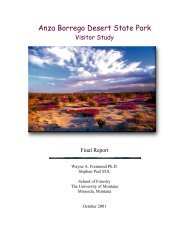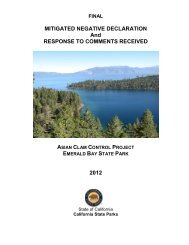Draft EIS/EIR for the San Luis Reservoir SRA Resource ...
Draft EIS/EIR for the San Luis Reservoir SRA Resource ...
Draft EIS/EIR for the San Luis Reservoir SRA Resource ...
Create successful ePaper yourself
Turn your PDF publications into a flip-book with our unique Google optimized e-Paper software.
Appendix B. Biological Survey Forms and Project Area Vegetation<br />
Blue Oak Woodland and Savanna<br />
The blue oak woodland and savanna occurs in <strong>San</strong> <strong>Luis</strong> W ildlife Area. Blue oak (Quercus<br />
douglas11) is <strong>the</strong> dominant tree of this woodland. An occasional coast live oak (Quercus<br />
agnfo/ia) also occurs in <strong>the</strong> blue oak woodland. The blue oak woodland occurs on <strong>the</strong> tops and<br />
sides of <strong>the</strong> ridges in small clumps. This cover of <strong>the</strong> blue oak woodland ranges from 80 to<br />
approximately 20 percent. Never<strong>the</strong>less, <strong>the</strong> blue oak woodland also grades into <strong>the</strong> blue oak and<br />
savanna vegetation type, which consists of a sparse cover of trees growing within grassland.<br />
The understory of <strong>the</strong> blue oak woodland mostly consists of various species of non-native grasses<br />
and occasional native species of <strong>for</strong>bs (non-grassy plants). The non-native species of grass<br />
include wild oats (Avena fatua) and ripgut brome (Bromus diandrus). Blue dicks (Dichelostemma<br />
capitatum) and clarkia (Clarkia sp.) also occur in <strong>the</strong> understory. Understory shrubs include<br />
Cali<strong>for</strong>nia sagebrush (Artemesia cali<strong>for</strong>nica), redberry (Rhamnus crocea), and eriophyllum<br />
(Enophyllum confertiflorum).<br />
Coast Live Oak Woodland<br />
The coast live oak woodland occurs in <strong>San</strong> <strong>Luis</strong> Wildlife Area. It consists of both blue and coast<br />
live oak tree s with Cali<strong>for</strong>nia bay (Umbellularia cali<strong>for</strong>nica), valley oak (Quercus lobata) , and<br />
Cali<strong>for</strong>nia buckeye (Aesculus cali<strong>for</strong>nica). Stands of this woodland type are generally not very<br />
large and occur in <strong>the</strong> canyon bottoms and on <strong>the</strong> shadier slopes. This oak woodland is very<br />
similar to <strong>the</strong> blue oak woodland except that <strong>the</strong> blue oaks are much fewer.<br />
The understory of <strong>the</strong> coast live oak woodland tends to support shrubs and <strong>for</strong>bs as opposed to<br />
grass. Species present in <strong>the</strong> understory include woodland sanicle (<strong>San</strong>icula crassicaule), blue<br />
wildrye (Elymus g/aucus), miner's lettuce (Claytonia perfoliata), fiesta flower (Pholistoma<br />
auritum), chickweed (Stellaria media), sweet pea (Lathyrus sp.), and bedstraw (Ga/ium apairne).<br />
Shrubs that occur in <strong>the</strong> understory are poison oak, toyon (Heteromeles arbutifolia), and redberry.<br />
Ornamental Trees<br />
Ornamental trees have been planted at <strong>the</strong> Basalt Campground, on <strong>the</strong> Madeiros site, and <strong>the</strong><br />
picnic areas of <strong>the</strong> <strong>San</strong> <strong>Luis</strong> Creek site. These trees include red ironbark gum (Eucalyptus<br />
sidiroxylon), allepo pine (Pinus halpensis), false pine (Casurina sp.), Chinese pistache (Pistachia<br />
chlnensls), eucalyptus (Eucalyptus spp.), and o<strong>the</strong>rs. The trees at Madieros are planted in a<br />
rectangular array, while those in <strong>the</strong> o<strong>the</strong>r areas con<strong>for</strong>m to picnic tables or campsites.<br />
Iodine Bush Scrub<br />
Iodine bush scrub occurs at Salt Spring, a tributary to Los Banos <strong>Reservoir</strong>. This area is very<br />
distinctive because of <strong>the</strong> presence of water and <strong>the</strong> pronounced salt deposits along <strong>the</strong> banks of<br />
<strong>the</strong> watercourse. The vegetation occurs within <strong>the</strong> banks of <strong>the</strong> watercourse at Salt Spring. This<br />
vegetation is dominated by iodine bush (Allenrolfea occidentalis), quail bush (Atriplex<br />
lenti<strong>for</strong>ms), alkali heath (Frankenia salina), and salt grass (Distichlis spicata). O<strong>the</strong>r species<br />
present include bassia (Bassia hyssopifolia), Fitch's spikeweed (Hemizonia fitch11) , and various<br />
species of saltbushes (Atriplex spp.).<br />
Cali<strong>for</strong>nia Sagebrush Scrub<br />
Cali<strong>for</strong>nia sagebrush scrub occurs on <strong>the</strong> shallow soils of hillsides above Los Banos <strong>Reservoir</strong><br />
and Los banos Creek in dry areas. It is dominated by Cali<strong>for</strong>nia sagebrush (Artemisia cali<strong>for</strong>nica)<br />
and Cali<strong>for</strong>nia buckwheat (Enogonum fasciculatum). The cover of <strong>the</strong> Cali<strong>for</strong>nia sagebrush scrub<br />
<strong>San</strong> <strong>Luis</strong> <strong>Reservoir</strong> <strong>SRA</strong> B-5<br />
<strong>Draft</strong> RMP/GP and <strong>Draft</strong> <strong>EIS</strong>/<strong>EIR</strong>
















